6 Executing Stored Procedures and Functions
This chapter shows you how to run stored procedures and functions using PHP and Oracle Database. It has the following topics:
The Anyco application is extended with a PL/SQL function to calculate remuneration for each employee, and is further extended with a PL/SQL procedure to return a REF CURSOR of employee records.
Using PL/SQL to Capture Business Logic
Oracle PL/SQL procedures and functions enable you to store business logic in the database for any client program to use. They also reduce the amount of data that must be transferred between the database and PHP and can help improve performance.
In this section, you will create a PL/SQL stored function to calculate and display the total remuneration for each employee.
To display the total remuneration of each employee, perform the following steps:
The PHP application connects to the database as the HR user. You may need to unlock the HR account as a user with DBA privileges. To unlock the HR user:
-
Open SQL Developer and open a connection to your Oracle database.
-
Login to your Oracle database as system.
-
Open SQL Worksheet or SQL*Plus and run the following
grantstatement to assign thecreate procedureprivilege to theHRuser:grant create procedure to hr;
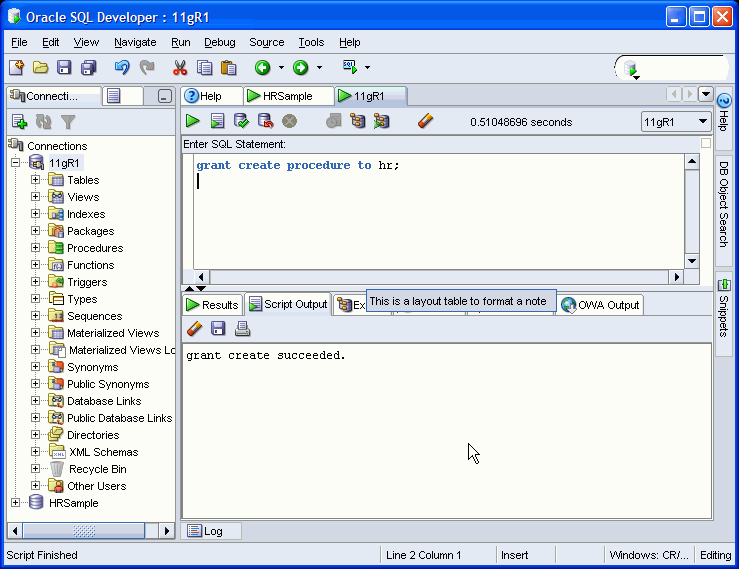
Description of the illustration chap6_hrgrantproc.gif
-
Login to your HR sample schema as
hr. -
Open SQL Worksheet or SQL*Plus and enter the following text to create a
calc_remuneration()function:create or replace function calc_remuneration( salary IN number, commission_pct IN number) return number is begin return ((salary*12) + (salary * 12 * nvl(commission_pct,0))); end;
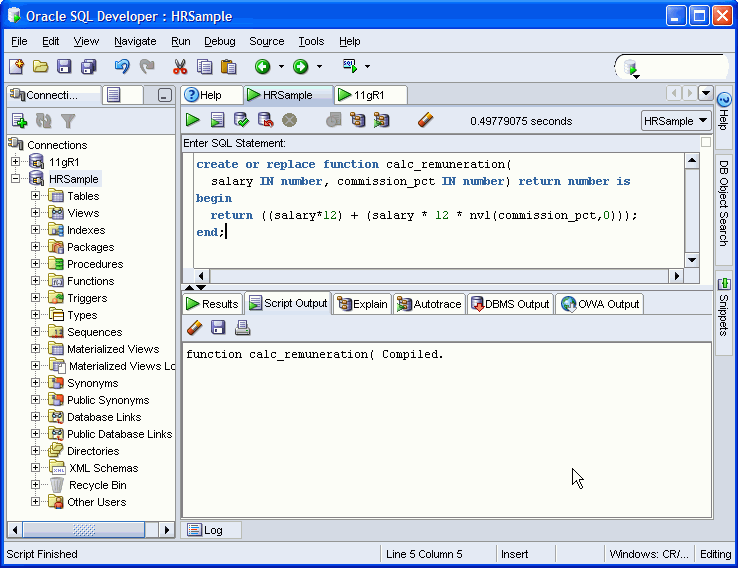
Description of the illustration chap6_hrcalcrem.gif
-
Create the
chap6directory, copy the application files fromchap5, and change to the newly created directory:On Windows:
mkdir c:\program files\Apache Group\Apache2\htdocs\chap6 cd c:\program files\Apache Group\Apache2\htdocs\chap6 copy ..\chap5\* .
On Linux:
mkdir $HOME/public_html/chap6 cd $HOME/public_html/chap6 cp ../chap5/* .
-
Edit the
anyco.phpfile. Modify the query in theconstruct_employees()function to call the PL/SQL function for each row returned:$query = "SELECT employee_id, substr(first_name,1,1) || '. '|| last_name as employee_name, hire_date, to_char(salary, '9999G999D99') as salary, nvl(commission_pct,0) as commission_pct, to_char(calc_remuneration(salary, commission_pct),'9999G999D99') as remuneration FROM employees WHERE department_id = :did ORDER BY employee_id ASC"; -
Edit the
anyco_ui.incfile. In theui_print_employees()function, add aRemunerationcolumn to the table, and modify theforeachloop to display the remuneration field for each employee:echo <<<END <form method="post" action="$posturl"> <table> <tr> <th> </th> <th>Employee<br>ID</th> <th>Employee<br>Name</th> <th>Hiredate</th> <th>Salary</th> <th>Commission<br>(%)</th> <th>Remuneration</th> </tr> END; // Write one row per employee foreach ($employeerecords as $emp) { echo '<tr>'; echo '<td><input type="radio" name="emprec" value="'.htmlentities($emp['EMPLOYEE_ID']).'"></td>'; echo '<td align="right">'.htmlentities($emp['EMPLOYEE_ID']).'</td>'; echo '<td>'.htmlentities($emp['EMPLOYEE_NAME']).'</td>'; echo '<td>'.htmlentities($emp['HIRE_DATE']).'</td>'; echo '<td align="right">'.htmlentities($emp['SALARY']).'</td>'; echo '<td align="right">'.htmlentities($emp['COMMISSION_PCT']).'</td>'; echo '<td align="right">'.htmlentities($emp['REMUNERATION']).'</td>'; echo '</tr>'; } -
Save the changes to your application files. In a browser, enter the following URL to test the application:
On Windows:
http://localhost/chap6/anyco.php
On Linux:
http://localhost/~<username>/chap6/anyco.php
-
In the Departments page, click Show Employees.
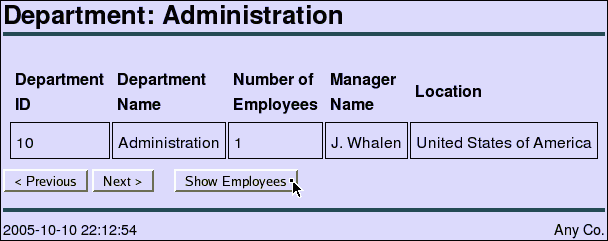
Description of the illustration chap6_stored_proc_test_001.gif
In the Employees page for the department, the employee remuneration is displayed in the last column:
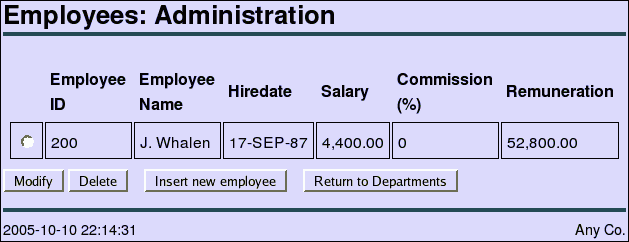
Description of the illustration chap6_stored_proc_test_002.gif
Using PL/SQL Ref Cursors to Return Result Sets
Query data can be returned as REF CURSORS from PL/SQL blocks and displayed in PHP. This can be useful where the data set requires complex functionality or where you want multiple application programs to use the same query.
A REF CURSOR in PL/SQL is a type definition that is assigned to a cursor variable. It is common to declare a PL/SQL type inside a package specification for reuse in other PL/SQL constructs, such as a package body.
In this section, you will use a REF CURSOR to retrieve the employees for a specific department.
To create a PL/SQL package specification and body, with a REF CURSOR to retrieve employees for a specific department, perform the following steps:
-
Open SQL Developer and login to your HR sample schema as
hr. -
Open SQL Worksheet or SQL*Plus and enter the following text to create the
cv_typesPL/SQL package:CREATE OR REPLACE PACKAGE cv_types AS TYPE empinfotyp IS REF CURSOR; PROCEDURE get_employees(deptid in number, employees in out empinfotyp); END cv_types;
Click Run:
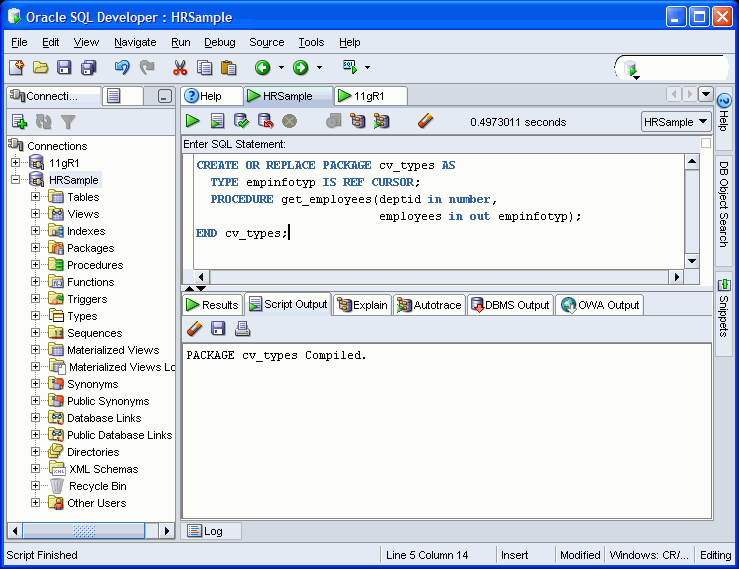
Description of the illustration chap6_hrcreatepack.gif
-
In SQL Worksheet enter the following text to create the
cv_typesPL/SQL package body:CREATE OR REPLACE PACKAGE BODY cv_types AS PROCEDURE get_employees(deptid in number, employees in out empinfotyp) IS BEGIN OPEN employees FOR SELECT employee_id, substr(first_name,1,1) || '. '|| last_name as employee_name, hire_date, to_char(salary, '999G999D99') as salary, NVL(commission_pct,0) as commission_pct, to_char(calc_remuneration(salary, commission_pct), '9999G999D99') as remuneration FROM employees WHERE department_id = deptid ORDER BY employee_id ASC; END get_employees; END cv_types;
Click Run:
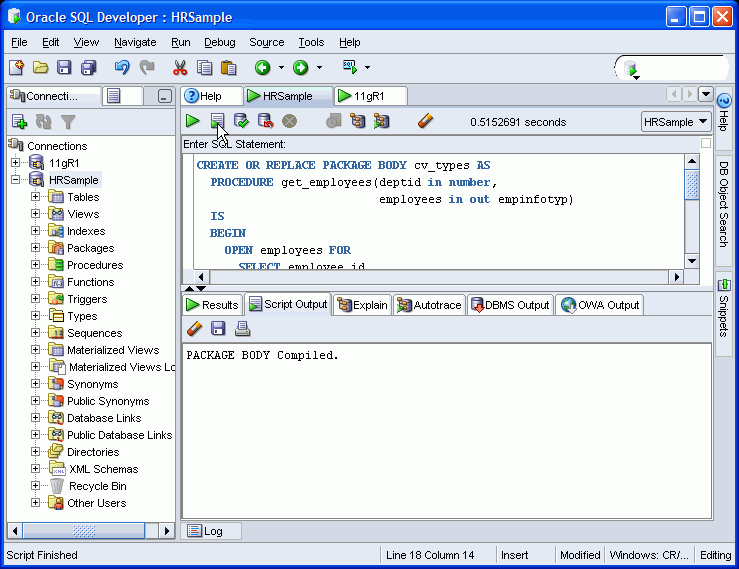
Description of the illustration chap6_hrcreatebody.gif
-
Edit the
anyco_db.incfile. Create a new PHP function that calls the PL/SQL packaged procedure:// Use ref cursor to fetch employee records // All records are retrieved - there is no paging in this example function db_get_employees_rc($conn, $deptid, &$e) { // Execute the call to the stored procedure $stmt = "BEGIN cv_types.get_employees($deptid, :rc); END;"; $stid = @oci_parse($conn, $stmt); if (!$stid) { $e = db_error($conn, __FILE__, __LINE__); return false; } $refcur = oci_new_cursor($conn); if (!$stid) { $e = db_error($conn, __FILE__, __LINE__); return false; } $r = @oci_bind_by_name($stid, ':RC', $refcur, -1, OCI_B_CURSOR); if (!$r) { $e = db_error($stid, __FILE__, __LINE__); return false; } $r = @oci_execute($stid); if (!$r) { $e = db_error($stid, __FILE__, __LINE__); return false; } // Now treat the ref cursor as a statement resource $r = @oci_execute($refcur, OCI_DEFAULT); if (!$r) { $e = db_error($refcur, __FILE__, __LINE__); return false; } $r = @oci_fetch_all($refcur, $employeerecords, null, null, OCI_FETCHSTATEMENT_BY_ROW); if (!$r) { $e = db_error($refcur, __FILE__, __LINE__); return false; } return ($employeerecords); }
The
db_get_employees_rc()function executes the following anonymous (unnamed) PL/SQL block:BEGIN cv_types.get_employees($deptid, :rc); END;
The PL/SQL statement inside the BEGIN END block calls the stored PL/SQL package procedure
cv_types.et_employees(). This returns anOCI_B_CURSORREF CURSOR bind variable in the PHP variable$refcur.The
$refcurvariable is treated like a statement handle returned byoci_parse(). It is used for execute and fetch operations just as if the SQL query had been done in PHP. -
Edit the
anyco.phpfile. In theconstruct_employees()function, remove the query text and the bind arguments. The function becomes:function construct_employees() { $deptid = $_SESSION['deptid']; $conn = db_connect($err); if (!$conn) { handle_error('Connection Error', $err); } else { $emp = db_get_employees_rc($conn, $deptid, $err); if (!$emp) { handle_error('Cannot fetch Employees', $err); } else { $deptname = get_dept_name($conn, $deptid); ui_print_header('Employees: '.$deptname); ui_print_employees($emp, $_SERVER['SCRIPT_NAME']); ui_print_footer(date('Y-m-d H:i:s')); } } } -
Save the changes to your application files. In a browser, enter the following URL to test the application:
On Windows:
http://localhost/chap6/anyco.php
On Linux:
http://localhost/~<username>/chap6/anyco.php
-
In the Departments page, click Next to navigate to the Marketing department page.
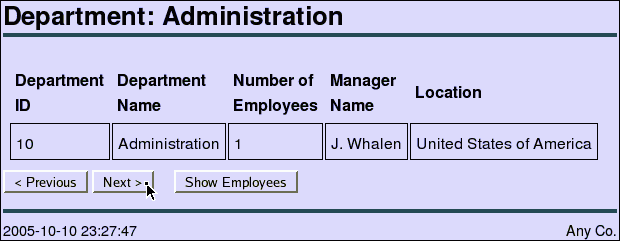
Description of the illustration chap6_refcursor_005.gif
-
In the Marketing department page, click Show Employees.
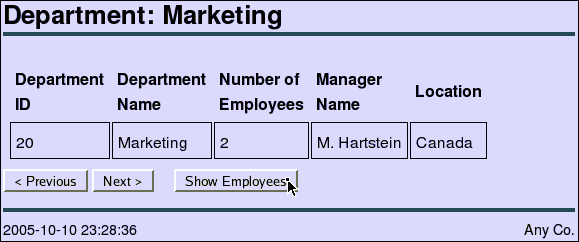
Description of the illustration chap6_refcursor_006.gif
In the Employees page for the Marketing department, the employee pages displays as previously:
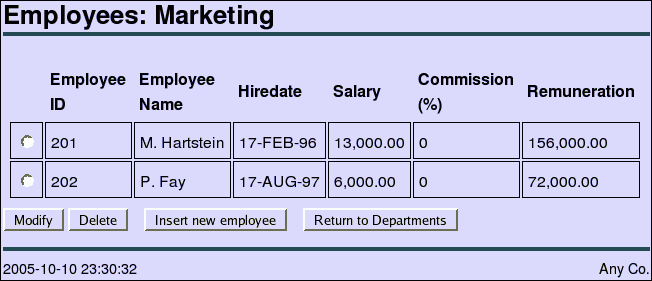
Description of the illustration chap6_refcursor_007.gif